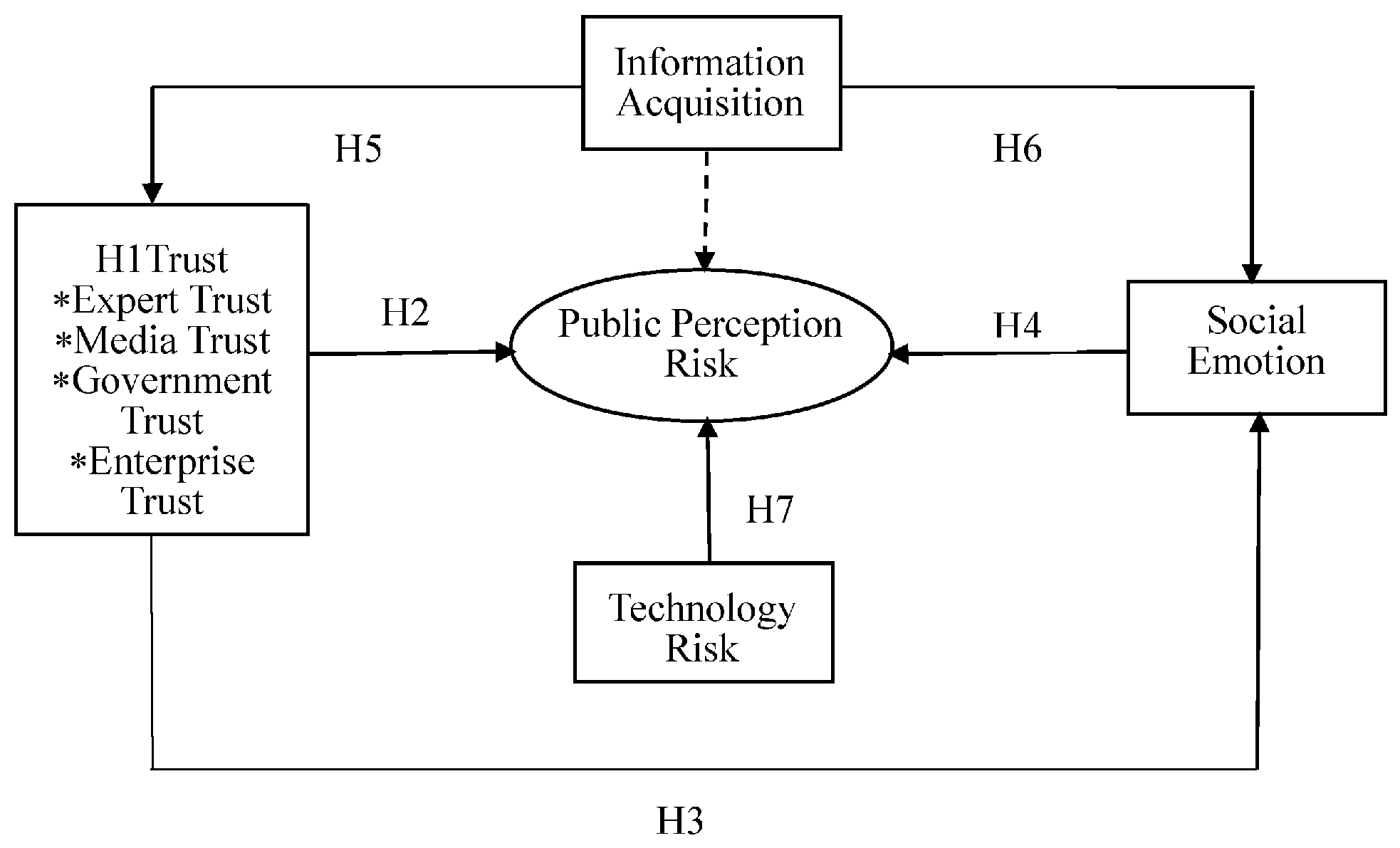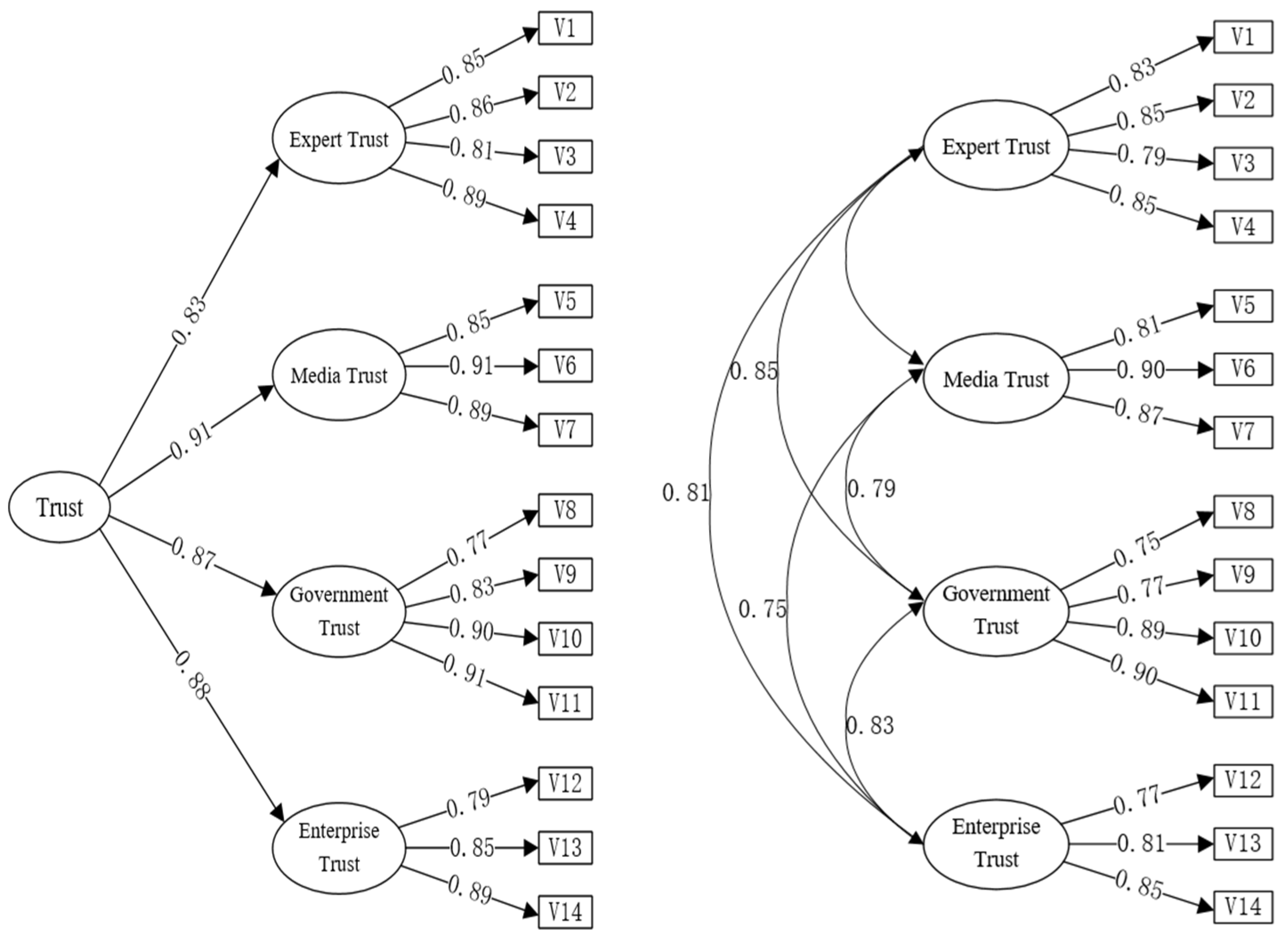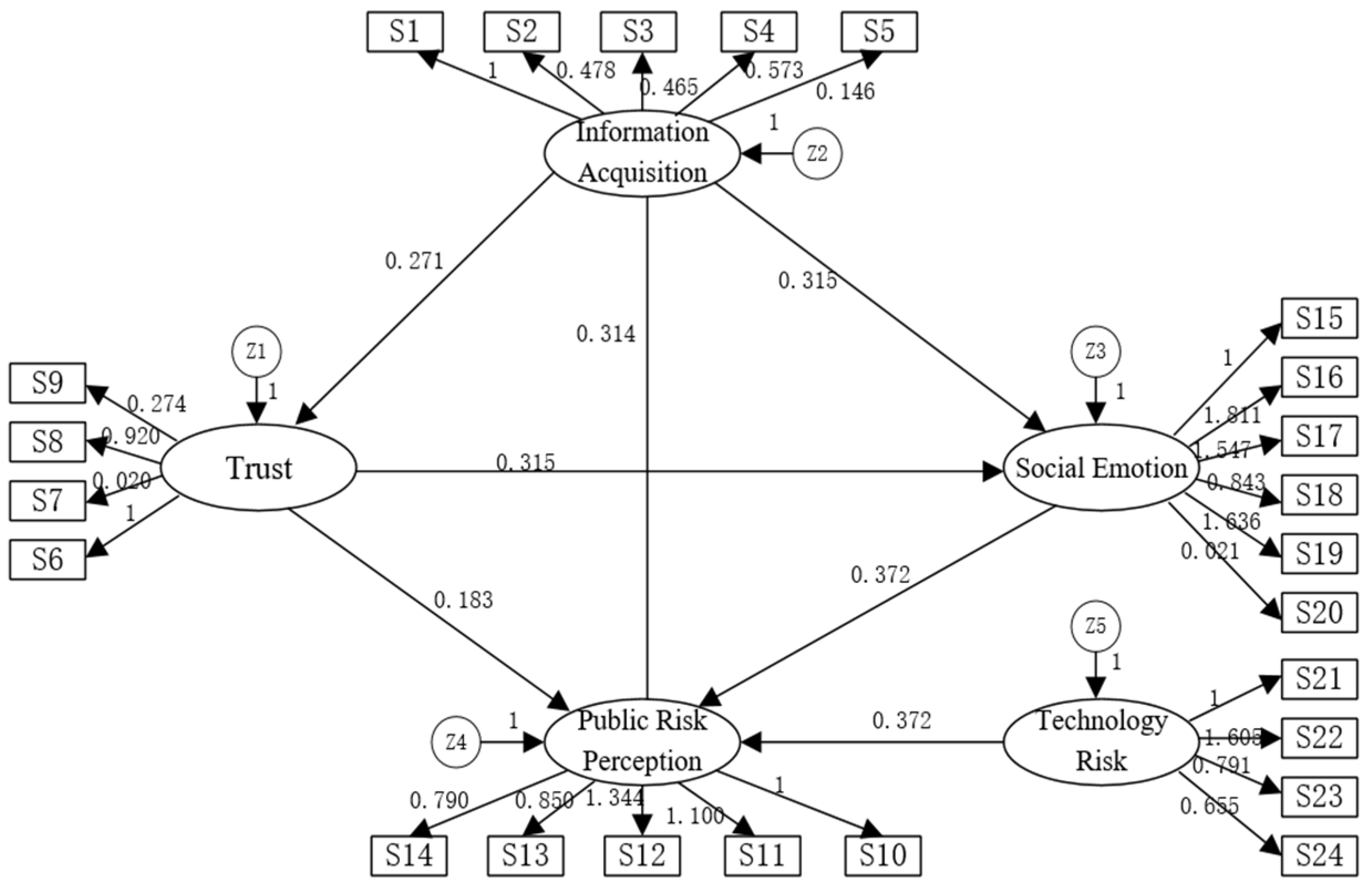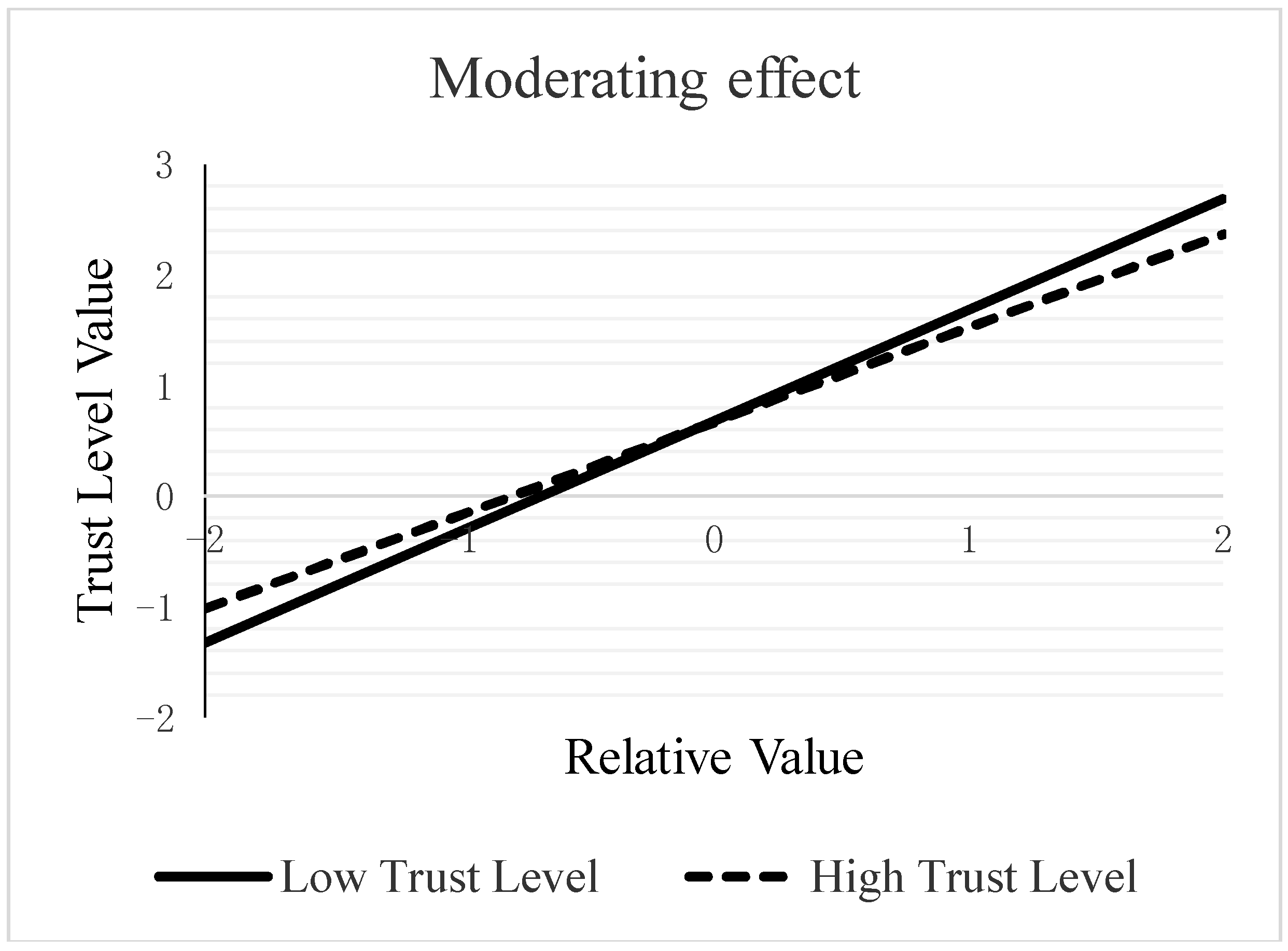Research on Factors Affecting Public Risk Perception of Thai High-Speed Railway Projects Based on “Belt and Road Initiative”
Abstract
:1. Introduction
2. Theoretical Background and Research Hypotheses
2.1. Important Role of Trust
2.2. Social Sentiment and Public Perception of Risk
2.3. Information Acquisition
2.4. Technology Risk and Public Risk Perception
2.5. Conceptual Model
3. Research and Design
3.1. Questionnaire Design and Variable Processing
3.2. Overall Sample Description and Data Collection
3.3. Reliability of Scale and Analysis of Validity
4. Verification and Modification of Model
4.1. Trust Second-Order Factor Model
4.2. Inspection and Correction of the Whole Model
4.3. Relationship among Social Emotion, Trust and Risk Perception
5. Conclusions
Supplementary Materials
Author Contributions
Funding
Conflicts of Interest
References
- Xinhua News Agency. Xi Jinping meets with Prime Minister of Thailand, Ba Yu. Xinhua, 9 November 2014. [Google Scholar]
- Xinhua News Agency. Xi Jinping meets with Prime Minister of Thailand, Ba Yu. Xinhua, 23 December 2014. [Google Scholar]
- Xie, X.F. Several psychological problems in risk studies. Psychol. Sci. 1994, 2, 104–108. [Google Scholar]
- Cox, D. Risk Handling in Consumer Behavior: An Intensive Study of Two Cases. In Risk-Taking and Information Handling in Consumer Behavior; Harvard University Press: Boston, MA, USA, 1967; pp. 34–81. [Google Scholar]
- Starr, C. Social Benefit versus Technological Risk. Science 1969, 165, 1232–1238. [Google Scholar] [CrossRef] [PubMed]
- Flynn, J.; Slovic, P.; Mertz, C. Gender, Race, and Perception of Environmental Health Risks. Risk Anal. 1994, 14, 1101–1108. [Google Scholar] [CrossRef] [PubMed] [Green Version]
- Lai, J.; Tao, J. Perception of Environmental Hazards in Hong Kong Chinese. Risk Anal. 2003, 23, 669–684. [Google Scholar] [PubMed]
- Lupton, D. Risk; Routledge: New York, NY, USA, 1999; pp. 28–33. [Google Scholar]
- O’Connor, R.E.; Bord, R.J.; Fisher, A. The curious impact of knowledge about climate change on risk perceptions and willingness to sacrifice. Risk Decis. Policy 1998, 3, 145–155. [Google Scholar] [CrossRef]
- Siegrist, M. The influence of trust and perceptions of risks and benefits on the acceptance of gene technology. Risk Anal. 2000, 20, 195–204. [Google Scholar] [CrossRef] [PubMed]
- Rosa, E.A.; Tuler, S.P.; Fischhoff, B.; Webler, T.; Friedman, S.M.; Sclove, R.E.; Shrader-Frechette, K.; English, M.R.; Kasperson, R.E.; Goble, R.L.; et al. Nuclear waste: Knowledge waste? Science (Washington) 2010, 329, 762–763. [Google Scholar] [CrossRef] [PubMed]
- Slovic, P.; Flynn, J.H.; Layman, M. Perceived risk, trust, and the politics of nuclear waste. Science 1991, 254, 1603–1607. [Google Scholar] [CrossRef] [PubMed]
- Bu, Y.M. Social amplification of risk: Framework and empirical research and implications. Study Pract. 2009, 12, 120–125. [Google Scholar]
- Quan, S.-W.; Zeng, Y.-C.; Huang, B. Public Perception and Acceptance of Nuclear Power. Beijing Soc. Sci. 2012, 5, 55–60. [Google Scholar]
- Earle, T.C.; Cvetkovich, G. Social Trust: Toward a Cosmopolitan Society; Greenwood Publishing Group: Westport, CT, USA, 1995. [Google Scholar]
- Siegrist, M.; Cvetkovich, G.; Roth, C. Salient value similarity, social trust, and risk/benefit perception. Risk Anal. 2000, 20, 353–362. [Google Scholar] [CrossRef] [PubMed]
- Bord, R.J.; O’Connor, R.E. Determinants of risk perceptions of a hazardous waste site. Risk Anal. 1992, 12, 411–416. [Google Scholar] [CrossRef]
- Flynn, J.; Burns, W.; Mertz, C.K.; Slovic, F. Trust as a determinant of opposition to a high-level radioactive waste repository: Analysis of a structural model. Risk Anal. 1992, 12, 417–429. [Google Scholar] [CrossRef]
- Groothuis, P.A.; Miller, G. The role of social distrust in risk-benefit analysis: A study of the siting of a hazardous waste disposal facility. J. Risk Uncertain. 1997, 15, 241–257. [Google Scholar] [CrossRef]
- Jungermann, H.; Pfister, H.R.; Fischer, K. Credibility, information preferences, and information interests. Risk Anal. 1996, 16, 251–261. [Google Scholar] [CrossRef]
- SiegrisL, M.; CveLkovich, G. Perception of Hazards: The Role of Social Trust and Knowledge. Risk Anal. 2000, 20, 713–720. [Google Scholar] [CrossRef]
- Sandman, P.M. Risk Communication: Facing Public Outrage. EPA J. 1987, 13, 21–22. [Google Scholar] [CrossRef]
- Finucane, M.L.; Alhakami, A.; Slovic, P.; Johnson, S.M. The affect heuristic in judgments of risks and benefits. J. Behav. Decis. Mak. 2000, 13, 1–17. [Google Scholar] [CrossRef] [Green Version]
- Epstein, S. Integration of the cognitive and psychodynamic unconscious. Am. Psychol. 1994, 49, 709–724. [Google Scholar] [CrossRef] [PubMed]
- Loewenstein, G.F.; Weber, E.U.; Hsee, C.K.; Welch, N. Risk as feelings. Psychol. Bull. 2001, 127, 267–286. [Google Scholar] [CrossRef] [PubMed]
- Wang, J.; Qi, L.; Zhou, Q. Review of Research on Influencing Factor of the Public’ Risk Perception. In Proceedings of the Conference on Psychology and Social Harmony (CPSH2012), Shanghai, China, 20–22 May 2012; pp. 485–488. [Google Scholar]
- Midden, C. Credibility and risk communication. In Proceedings of the International Workshop on Risk Communication, Juelich, Germany, 17–20 October 1988; Volume 17, p. 21. [Google Scholar]
- Lichtenthaler, U.; Lichtenthaler, E. A Capability-Based Framework for Open Innovation: Complementing Absorptive Capacity. J. Manag. Stud. 2009, 46, 1315–1338. [Google Scholar] [CrossRef]
- Marsh, H.W.; Hocevar, D. Application of confirmatory factor analysis to the study of self-concept: First-and higher order factor models and their invariance across groups. Psychol. Bull. 1985, 97, 562. [Google Scholar] [CrossRef]
- Wen, Z.; Hau, K.-T.; Chang, L. A Compar Ison Ofmoderator Andmed Iator and Their Applications. Acta Psychol. Sin. 2005, 37, 268–274. [Google Scholar]




| Statistical Content | Category | Sample Number | Proportion |
|---|---|---|---|
| Gender | Male | 301 | 44.59% |
| Female | 374 | 55.41% | |
| Age | Under 20 | 88 | 13.03% |
| 20~30 | 196 | 29.04% | |
| 30~40 | 167 | 24.74% | |
| 40~50 | 113 | 16.74% | |
| 50~60 | 87 | 12.89% | |
| 60 and above | 24 | 3.56% | |
| Education | Junior High School | 132 | 19.56% |
| High School | 154 | 51.56% | |
| Undergraduate | 348 | 8.94% | |
| Postgraduate | 41 | 6.07% | |
| Occupation | Party and Government Officer | 49 | 7.26% |
| Institution Officer | 94 | 13.93% | |
| Enterprise officer | 146 | 21.63% | |
| Professional and Technical Personnel (Teachers, Doctors, Engineers) | 67 | 9.93% | |
| Student | 219 | 32.45% | |
| Retired | 29 | 4.30% | |
| Freelance | 45 | 6.65% | |
| Others | 26 | 3.85% |
| Variable | Item | Factor Loading | Cronbach’s α | Variable Index Correlation Coefficient (Range) |
|---|---|---|---|---|
| Information Acquisition (IA) | Railway Accident Information (IA1) | 0.680 | 0.933 | 0.523–0.597 |
| Railway Safety Information (IA2) | 0.448 | |||
| Reducing Railway Hazard Information (IA3) | 0.480 | |||
| Railway Project Operation Supervision Support Information (IA4) | 0.557 | |||
| Railway Transportation Efficiency Guarantee Information (IA5) | 0.309 | |||
| Risk Perception (RP) | Visibility (RP1) | 0.960 | 0.975 | 0.521–0.644 |
| Frightening (RP2) | 0.662 | |||
| Possibility (RP3) | 0.604 | |||
| Seriousness (RP3) | 0.608 | |||
| Controllability (RP4) | 0.962 | |||
| Social Emotion (SE) | Unconvinced (SE1) | 0.849 | 0.973 | 0.507–0.654 |
| Worry (SE 2) | 0.875 | |||
| Tense or Anxious (SE3) | 0.875 | |||
| Discontent or Dislike (SE4) | 0.477 | |||
| Scared or Frightened (SE5) | 0.855 | |||
| Anger (SE6) | 0.888 | |||
| Technology Risk (TR) | Technical Capability (TR1) | 0.854 | 0.982 | 0.566–0.671 |
| Risk Control Ability(TR2) | 0.854 | |||
| System Technical Performance (TR3) | 0.791 | |||
| Technology Risk Management (TR4) | 0.655 | |||
| Expert Trust (ExT) | Evaluation Ability (ExT1) | 0.749 | 0.984 | 0.575–0.691 |
| Speech Authenticity (ExT2) | 0.709 | |||
| Accountability (ExT3) | 0.633 | |||
| Reliability (ExT4) | 0.672 | |||
| Media Trust (MT) | Reporting Authenticity (MT1) | 0.778 | 0.947 | 0.540–0.691 |
| Report Timely (MT2) | 0.745 | |||
| Responsibility (MT3) | 0.772 | |||
| Government Trust (GT) | Political Reliability (MT4) | 0.602 | 0.985 | 0.478–0.551 |
| Possibility of Supervision and Management System (GT1) | 0.564 | |||
| Feasibility of Decision Making (GT2) | 0.941 | |||
| Emergency Management Practicability (GT3) | 0.672 | |||
| Enterprise Trust (ET) | Managerial Competence and Empirical Reliability (ET1) | 0.728 | 0.976 | 0.484–0.569 |
| Rationality of Decision Process (ET2) | 0.762 | |||
| Fund Reliability (ET3) | 0.778 |
| Model | Chi-Square | df | Chi-Square/df | GFI | RMSEA | CFI | AGFI | NFI |
|---|---|---|---|---|---|---|---|---|
| Associated First-order Factor | 139.337 | 71 | 1.962 | 0.971 | 0.038 | 0.949 | 0.958 | 0.903 |
| second-order Factor | 159.238 | 73 | 2.181 | 0.939 | 0.058 | 0.955 | 0.925 | 0.934 |
| Model | Chi-Square | df | Chi-Square/df | GFI | RMSEA | CFI | AGFI | NFI |
|---|---|---|---|---|---|---|---|---|
| Original Model | 1477.009 | 202 | 7.312 | 0.863 | 0.097 | 0.536 | 0.829 | 0.504 |
| Modified Model | 352.311 | 198 | 1.779 | 0.955 | 0.034 | 0.944 | 0.943 | 0.882 |
| Estimate | S.E. | C.R. | p | Label | |||
|---|---|---|---|---|---|---|---|
| Trust | <--- | Information Acquisition | 0.271 | 0.125 | 1.923 | 0.016 | par_1 |
| Social Emotion | <--- | Information Acquisition | 0.315 | 0.108 | 2.925 | 0.002 | par_3 |
| Social Emotion | <--- | Trust | 0.315 | 0.108 | 2.925 | 0.002 | par_6 |
| Perception Risk | <--- | Information Acquisition | 0.314 | 0.119 | 2.628 | 0.031 | par_2 |
| Perception Risk | <--- | Trust | 0.183 | 0.105 | 1.742 | 0.082 | par_4 |
| Perception Risk | <--- | Social Emotion | 0.372 | 0.174 | 2.965 | *** | par_5 |
| Perception Risk | <--- | Technology Risk | 0.355 | 0.150 | 3.132 | *** | par_23 |
| S1 | <--- | Information Acquisition | 1.000 | ||||
| S2 | <--- | Information Acquisition | 0.478 | 0.201 | 2.376 | 0.017 | par_7 |
| S3 | <--- | Information Acquisition | 0.465 | 0.220 | 2.115 | 0.034 | par_8 |
| S4 | <--- | Information Acquisition | 0.573 | 0.219 | 2.616 | 0.009 | par_9 |
| S5 | <--- | Information Acquisition | 0.146 | 0.108 | 1.353 | 0.176 | par_10 |
| S6 | <--- | Trust | 1.000 | ||||
| S7 | <--- | Trust | 0.020 | 0.084 | 0.237 | 0.812 | par_11 |
| S8 | <--- | Trust | 0.920 | 0.223 | 4.118 | *** | par_12 |
| S9 | <--- | Trust | 0.274 | 0.069 | 3.988 | *** | par_13 |
| S10 | <--- | Perception Risk | 1.000 | ||||
| S11 | <--- | Perception Risk | 1.100 | 0.160 | 6.862 | *** | par_14 |
| S12 | <--- | Perception Risk | 1.344 | 0.177 | 7.584 | *** | par_15 |
| S13 | <--- | Perception Risk | 0.850 | 0.129 | 6.594 | *** | par_16 |
| S14 | <--- | Perception Risk | 0.790 | 0.134 | 5.901 | *** | par_17 |
| S15 | <--- | Social Emotion | 1.000 | ||||
| S16 | <--- | Social Emotion | 1.811 | 0.389 | 4.838 | *** | par_18 |
| S17 | <--- | Social Emotion | 1.547 | 0.341 | 4.934 | *** | par_19 |
| S18 | <--- | Social Emotion | 0.843 | 0.252 | 3.350 | 0.003 | par_20 |
| S19 | <--- | Social Emotion | 0.636 | 0.244 | 2.612 | 0.009 | par_21 |
| S20 | <--- | Social Emotion | 0.021 | 0.050 | 0.414 | 0.679 | par_24 |
| S21 | <--- | Technology Risk | 1.000 | ||||
| S22 | <--- | Technology Risk | 1.605 | 0.561 | 4.890 | *** | par_22 |
| S23 | <--- | Technology Risk | 0.791 | 0.231 | 4.631 | *** | par_25 |
| S24 | <--- | Technology Risk | 0.655 | 0.145 | 3.547 | *** | par_26 |
| Dependent Variable | Public Perception Risk | ||
|---|---|---|---|
| Model-1 | Model-2 | ||
| Intercept Term | 11.646 | −0.853 | |
| Independent Variable | Trust | −0.003 | 0.266 * |
| Social Emotion | 0.253 ** | 0.923 ** | |
| Trust × Social Emotion | −0.014 ** | ||
| R2 | 0.057 | 0.063 | |
| ΔR2 | 0.007 * | ||
© 2018 by the authors. Licensee MDPI, Basel, Switzerland. This article is an open access article distributed under the terms and conditions of the Creative Commons Attribution (CC BY) license (http://creativecommons.org/licenses/by/4.0/).
Share and Cite
Ploywarin, S.; Song, Y.; Sun, D. Research on Factors Affecting Public Risk Perception of Thai High-Speed Railway Projects Based on “Belt and Road Initiative”. Sustainability 2018, 10, 1978. https://doi.org/10.3390/su10061978
Ploywarin S, Song Y, Sun D. Research on Factors Affecting Public Risk Perception of Thai High-Speed Railway Projects Based on “Belt and Road Initiative”. Sustainability. 2018; 10(6):1978. https://doi.org/10.3390/su10061978
Chicago/Turabian StylePloywarin, Sangsomboon, Yan Song, and Dian Sun. 2018. "Research on Factors Affecting Public Risk Perception of Thai High-Speed Railway Projects Based on “Belt and Road Initiative”" Sustainability 10, no. 6: 1978. https://doi.org/10.3390/su10061978





